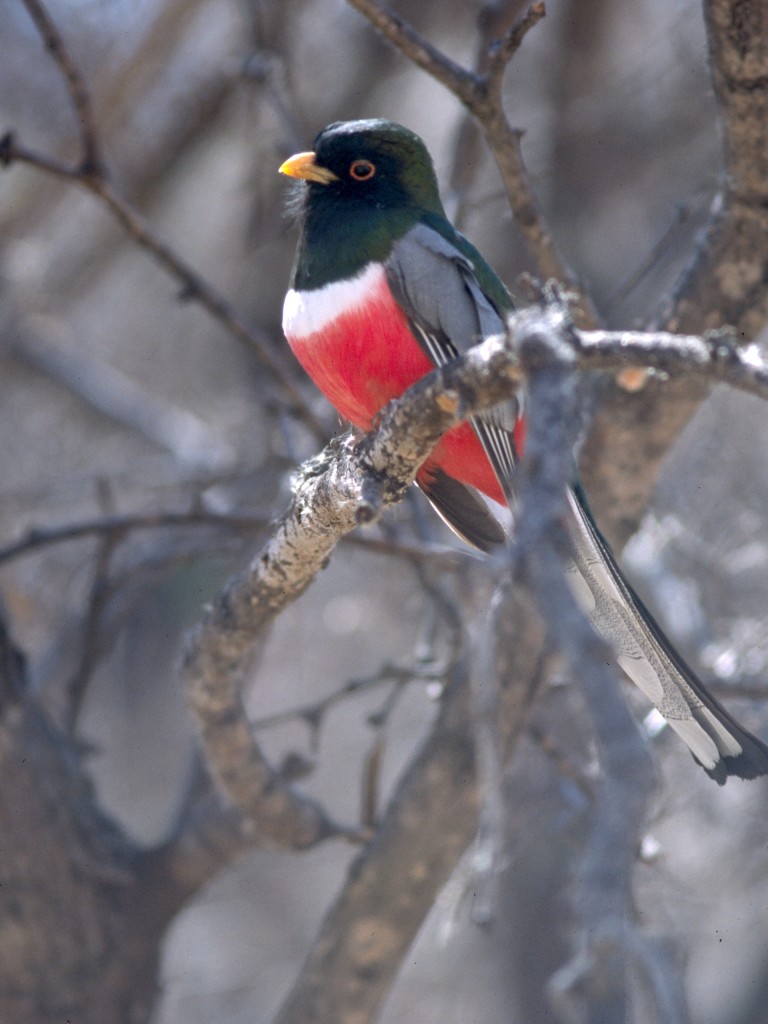Imagine coming across a hungry tiger. It fixes its gaze on you, and roars. You have three options: you can stay and fight, you can run, or you can strike your best pose and hope your assailant is deterred. That last option probably wasn’t your first choice; making yourself more enticing is probably the last thing you want.
Visual displays such as posing are common in the animal kingdom. Often, such displays have a target audience. In many species of birds, for example, individuals will threaten each other. Interestingly, such interactions can actually prevent situations from escalating into violence. Visual demonstrations can also be used in attracting and competing for mates. Other displays can deter predators. So, while certain behaviors can be used to signal either within a species (intraspecific) or to another species (interspecific), very few signals straddle that boundary.
But apparently, the elegant trogon (Trogon elegans), a bird native to the southern United States and northern Costa Rica, uses one signal in both courtship and predator-deterrence; it raises its tail to expose the bright red plumage of its underside.
Pierre-Paul Bitton and Stéphanie M. Doucet from the University of Windsor noticed that previous scientific literature had described this tail-raising behavior either in mating or in response to other species. They set out to determine what would prompt this response from elegant trogons, as well as the function of this behavior when used interspecifically.
The Experiments
To get an idea of when elegant trogons raised their tails, Bitton and Doucet spent hundreds of hours in 2010 and 2011 observing them and noting the sex and age of the individuals performing and of conspecifics (members of the same species) in the area. The authors observed that trogons raised their tails to signal each other, both within a sex and to the other sex. They also noted that the birds would raise their tails in response to members of other species, humans, in particular.
Pitton and Doucet also tested the hypothesis that tail-raises could also be used to deter predators by constructing models of the collared forest falcon, a common predator of the trogons. They also constructed models of squirrel cuckoos, a non-threatening bird with a silhouette comparable to that of the falcons, in order to control for variables such as size and shape. The models were placed in strategic locations in order to lure trogons and observe their subsequent responses. They found that trogons were much more likely to raise their tails in encounters with the falcon models than with the non-threatening cuckoo models. Additionally, tail-raises happened much more frequently when the trogons were close to the falcon models.
These two experiments demonstrated that trogons indeed raise their tails to deter predators as well as to communicate with their own species. The evidence supported the conclusion that trogons use the same behavior to attract mates, communicate with each other, and tell predators to back off.
It’s possible that Bitton and Doucet missed something important. Most birds can perceive UV light, which can influence how they appear to other birds based on the UV reflectance or absorbance of their plumage. As the models did not emulate UV reflectance patterns, it’s conceivable that trogons responded differently to the falcon and cuckoo models than they otherwise would have. Given that the trogons responded to a wide range of other potential predators, however, it’s probably a minor oversight.
While there are plenty of examples of multifunctional bird songs that are meant for both intraspecific and interspecific use, this study uncovered a visual signal with the same range of purposes, which is rare. It’s really quite elegant; Need a mate? Dealing with pesky intruders? About to be eaten? Raising your tail is the universal gesture.
Bitton, P. and Doucet, S.M. 2014. A multifunctional visual display in elegant trogons targets conspecifics and heterospecifics. Behavioural Ecology 25: 27-34.

